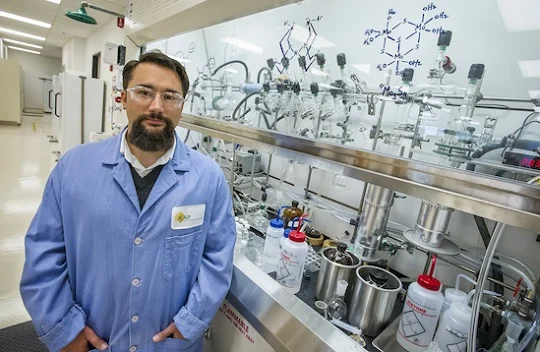We’ve gotten pretty good at turning solar power into electricity, but electricity can be hard to store, making it a challenge for use right when you need it and in the transportation sector.
That’s what makes it worth following any news of progress out of the Joint Center for Artificial Photosynthesis, the Energy Innovation Hub developed at the Berkeley Lab and Caltech by the Department of Energy under Steven Chu’s watch.

Berkeley researcher Gary Moore. (image via Lawrence Berkeley National Laboratory)
Artificial photosynthesis is the attempt to create what are sometimes called “bionic leaves” that mirror and actually improve upon what a plant does, harvesting the energy of sunlight and producing a fuel – namely, hydrogen – from water and carbon dioxide leaving just oxygen as a byproduct.
Late last week, researchers working at the center said they’d made a breakthrough – essentially combining light-absorption and fuel-producing catalyst structures and functions. ”In previous efforts to produce hydrogen fuel, catalysts have been immobilized on non-photoactive substrates,” the Berkeley Lab said in a release. “This approach requires the application of an external electrical potential to generate hydrogen.
With the new approach, the researchers began with the semiconductor gallium phosphide, specially coated and treated to keep it stable and boost fuel production, and then grafted a cobalt-containing hydrogen production catalyst to it.
“In coupling the absorption of visible light with the production of hydrogen in one material, we can generate a fuel simply by illuminating our photocathode,” principal investigator Gary Moore, of the Berkeley Lab, said in a statement. “No external electrochemical forward biasing is required.”
As good as all this sounds, the researchers say that they’re looking forward to taking this modular method and seeing how it could work with other light-aborber, linking materials and catalysts.
“It can be adapted for use with other catalysts tethered over structured photocathodes as new materials and discoveries emerge,” Moore said. “This could allow us, for example, to replace the precious metal catalysts currently used in many solar-fuel generator prototypes with catalysts made from earth-abundant elements.”
The paper describing this research, “Photofunctional Construct That Interfaces Molecular Cobalt-Based Catalysts for H2Production to a Visible-Light-Absorbing Semiconductor,” was published in the Journal of the American Chemical Society (JACS). The abstract is available here.






